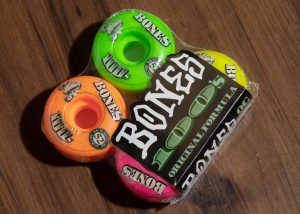San Leandro, CA – Skate Shop News: Does the Size of Your Wheel Matter??
Posted in: Uncategorized
 Kick. Push. Coast.
Kick. Push. Coast.
The standard mechanics of riding a board. Have you ever stopped to think what you are actually coasting on, or if it’s even the right size for you?
The wheels of a skateboard are usually made of polyurethane, and come in many different sizes and shapes to suit different types of skating. Larger diameters (55–85 mm) roll faster, and move more easily over cracks in pavement and are better for transition skateboarding.
Smaller diameters (48–54 mm) keep the board closer to the ground, require less force to accelerate and produce a lower center of gravity which allows for a better response time, but also make for a slower top speed and are better for street skateboarding.
Wheels also are available in a variety of hardnesses usually measured on the Shore durometer “A” scale. Again like car tires, wheels range from the very soft (about Shore A 75) to the very hard (about Shore A 101). As  the A scale stops at 100, any wheels labeled 101A or higher are harder, but do not use the appropriate durometer scale. Some wheel manufacturers now use the “B” or “D” scales, which have a larger and more accurate range of hardness.
the A scale stops at 100, any wheels labeled 101A or higher are harder, but do not use the appropriate durometer scale. Some wheel manufacturers now use the “B” or “D” scales, which have a larger and more accurate range of hardness.
 Most street skaters prefer medium-sized wheels (usually 51–54 mm), as small wheels with lighter trucks can make flip tricks easier by keeping the center of gravity of the skateboard closer to the deck, thus making the deck easier to spin. Street wheels are harder (A 100/A 101).
Most street skaters prefer medium-sized wheels (usually 51–54 mm), as small wheels with lighter trucks can make flip tricks easier by keeping the center of gravity of the skateboard closer to the deck, thus making the deck easier to spin. Street wheels are harder (A 100/A 101).
Transition or Vert skating usually requires larger wheels (usually 55–65 mm), as it involves higher speeds. Vert wheels are also usually slightly softer (A 98/ A 99), allowing them to maintain high speed on ramps without sliding. Downhill skating requires even larger wheels (60–100 mm) to sustain the highest speeds possible. They also need to be soft and have better grip to make the tight and frequent turns. These extreme sizes of wheels almost always have cores of hard plastic that can be made thinner and lighter than a solid polyurethane wheel. They are often used by skateboard videographers as well, as they minimize noise and roll smoothly over most types of terrain.
These are just general guidelines, it all comes down to personal preference. In the 80′ and 90’s they rode street wheels on the transitions, and now some folks are riding big wheels in the street. Skateboarding remains true to form. Whatever feels the best is what you should do. Stop by Orbit Skate today and check out our amazing selection of all durometers and sizes for all terrains!!
Return to: San Leandro, CA – Skate Shop News: Does the Size of Your Wheel Matter??
Social Web